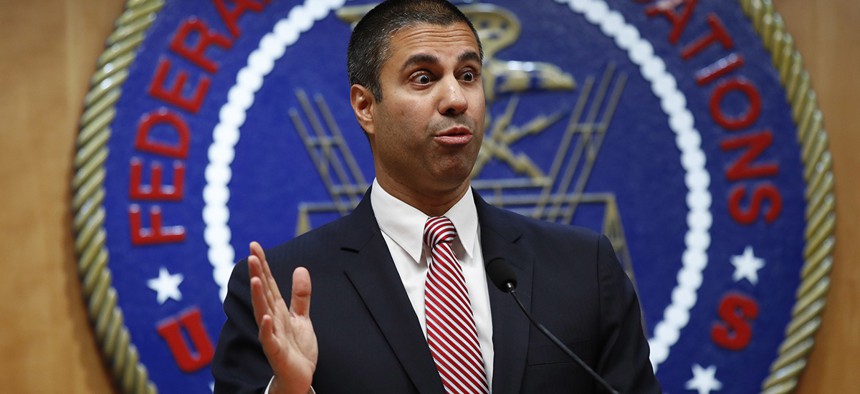Dear State and Local Gov: FCC Chair Ajit Pai Is Just Not That Into You

FCC Chairman Ajit Pai Jacquelyn Martin/AP
Pai even blew up an intergovernmental advisory committee after members asked to talk to him about its future.
WASHINGTON — If Federal Communications Commission Chairman Ajit Pai was trying to signal the dismissal of the role of state and local governments in broadband and other key telecommunications issues, the past few months couldn’t have been a clearer indication.
Since November, Pai has attracted concerned letters from members of Congress, major national organizations representing local governments and members of internal advisory committees. In interviews with state and local government officials, FCC advisory committee members and outside stakeholders, sources have described to Route Fifty an FCC which is focused on industry’s demands of state and local government over an intergovernmental partnership.
That was on display this week as the Federal Communications Committee’s Broadband Deployment Advisory Committee—whose members are primarily private sector telecommunications leaders—sat down to discuss a range or proposals it has been drafting.
The committee, referred to as the BDAC (pronounced Bee-DACK) in FCC-speak, discussed wide-ranging draft policy guidance for statesand municipalities. On page 50 of the state model code was a recommendation to push local governments to de-prioritize publicly funded municipal broadband. There were also working group recommendations on “removing state and local regulatory barriers” that focused on all the ways state and local governments were believed to be holding back innovation.
The group also debated when and how the FCC should preempt state and local authorities on telecommunications concerns, with one participants stating that while they couldn’t agree on preemption language yet, ultimately, it will be in there.
San José Mayor Sam Liccardo, one of the four state and local representatives on the BDAC, submitted comments with the FCC on behalf of his city along with a joint letter with local leaders from New York City and McAllen, Texas expressing concern about the committee’s processes, writing: “It is no secret that there remain concerns about the tilted imbalance of the BDAC membership and the evenhandedness and transparency of the process of developing BDAC recommendations.”
The city also claimed that municipal members of the committee have been restricted from sharing internal documents with their public sector colleagues “while the same limitations did not apply on the industry side.”
The National Association of Counties, National League of Cities, and U.S. Conference of Mayors sent a joint letter urging Pai “to more fully consider local perspectives” on wireline and wireless broadband decisions, including a request to “provide for an appropriate level of local government representation” on the BDAC. Unlike most letters from the national organizations, this one was co-signed by 233 local officials from across the nation.
U.S. Rep. Anna Eshoo, a California Democrat who represents part of Silicon Valley, and 14 of her congressional colleagues also sent a letter to Pai expressing concern that the composition of the BDAC was over 75 percent representatives of industry. "We are concerned that the composition of the 30-member BDAC relies too heavily on the input of industry voices and less on public officials who are responsible for protecting the public interest and who understand the issues and perspectives of local communities nationwide,” Eshoo and her colleagues wrote to Pai.
“The entire problem is framed as ‘the issue around broadband deployment is state and local government regulations,’” San Jose Chief Innovation Officer Shireen Santosham told Route Fifty in an interview, when explaining the city’s concerns over the direction of the BDAC. “We’re not talking about what the industry has contributed in terms of lack of deployment and closing the digital divide. We’re focusing almost exclusively on the challenges around city and state regulation.”
Santosham, who represents Mayor Liccardo on the BDAC and is involved in the day-to-day discussions of the working groups, acknowledges there are certainly things states and localities can do better, “but right now it seems very one-sided.”
In prepared remarks for the BDAC delivered on Wednesday, Democratic Commissioner Mignon Clyburn expressed concern that “concerns of localities do not appear to have been fully addressed” in the reports filed by the BDAC.
Exploding the IAC
Incidentally, the FCC has a long-standing committee set up for in-depth discussions on intergovernmental issues. It is known as the Intergovernmental Advisory Committee; and, last month, after largely neglecting it for one year, the FCC decided to blow it up.
The IAC is chaired by Elin Swanson Katz, consumer counsel for the state of Connecticut. In November, she sent a letter to Pai on behalf of the members of the IAC. In the letter, Katz claimed the members were “frustrated” by the direction of the committee over the past year, citing long presentations without any dialogue “around issues that are of central importance to the Membership and the diverse communities we represent, particularly around broadband deployment.”
The two-decade-old IAC was created “to provide guidance to the Commission on issues of importance to state, local and tribal governments,” as well as anything else they decided to send its way. With state and local governments playing a significant role in how broadband providers reach customers, the siting of telecommunications towers, 9-1-1 systems and other public safety communications—all issues the FCC promulgates rules around—there are plenty of critical conversations for the FCC to engage in with a body of knowledgeable state and local partners.
However, according to members of the committee and stakeholders, the body has been deterred from weighing in on major issues facing the commission—particularly around broadband.
“Our deliberations are not public, so the traditional process is the IAC would submit draft recommendations to the commission for consideration. This version of the IAC has not submitted any,” Katz told Route Fifty. “We have felt discouraged from really opining on broadband deployment issues including public rights of way and potential preemption issues.”
This includes the repeal of the net neutrality framework in the Restoring Internet Freedom Order—an action that was accompanied by warnings to state and local government against attempting to regulate in that area. The IAC was also not asked to provide advice on dockets related to wireline or wireless infrastructure despite interest from members of the IAC.
Beyond broadband, the committee was not invited to submit their recommendations on other key issues of importance to state and local government such as the elimination of the “main studio rule,” which requires “each AM, FM, and television broadcast station to maintain a main studio located in or near its community of license … to ensure stations would be accessible and responsive to their communities.” These local stations are a key source of public education on local policies, as well as a vital communication line during emergencies.
Katz invited Pai to join the IAC’s January meeting to have a conversation about the committee’s future. After receiving the letter, Pai cancelled the January meeting altogether and announced his decision to overhaul the committee, announcing that the FCC is accepting applications to expand its membership from 15 to 30 people. In his statement announcing the expansion, Pai said the FCC would now wait until after the committee is at “full strength” prior to reconvening—effectively shutting down the committee until further notice.
“My understanding is not only did he not take her up on her request, but she never heard back from him,” Committee Member Ken Fellman told Route Fifty.
Fellman is not new to the committee, having served on the committee at its inception in 1997, as well as multiple other terms under “five or more" FCC chairman of varying political parties.
“In the past—at least in my experience—the IAC, even when it philosophically wasn’t as much on the same page as the leadership at the Commission, it seemed to me there was always an opportunity for dialogue and there was usually an opportunity for recommendations,” Fellman explained. “What I have felt with the current IAC is there is not as much interest from the commission leadership in hearing ‘what does the IAC think is important.’”
Vice Chair Andy Huckaba, a Republican councilmember from Lenexa, Kansas, told Route Fifty he has also raised concerns about the IAC’s direction personally, as well, describing the situation as a “mini crisis” for the consultative body. Huckaba said that while his previous two, two-year terms with the committee have been active in discussing key issues and writing opinions, this year, Huckaba explained, “We’ve been quieted as far as our discussion.”
Huckaba is the only member of the IAC that also sits on the BDAC. However, he was not an initial member; he was added only after a request from the IAC.
“The Intergovernmental Advisory Committee is a key advisory group for the Commission,” Patrick Webre, acting chief of the FCC’s Consumer and Governmental Affairs Bureau, told Route Fifty via email. “We have expanded its membership to match the size of our other advisory committees and we are excited to bring in new voices and diverse perspectives to work with the outstanding members already on the Committee and our staff. Chairman Pai is looking for the committee to help the agency better engage with state, local and tribal partners especially in areas of consumer engagement.”
The FCC declined to answer follow-up questions regarding whether the expansion of the Committee was discussed with the current IAC members, as well as anything else the committee has been focused on or contributing to as far as the FCC's knowledge.
Multiple sources say those on the committee are questioning the ongoing value of their work; as public servants, most of the committee members on the IAC pay their own way or utilize taxpayer funding to attend the meetings. At least one member takes personal vacation time to attend. For some, there is a question as to whether it is worth continuing on.
“I don’t want to go out on a limb and say I don’t think they care or I don’t think they want to hear from us, but I will say I don’t know that and I’m concerned about it,” Fellman said. “Our leadership has requested we engage in that [conversation] and it hasn’t happened—so I don’t know and it’s frustrating. It’s very frustrating.”
In the meantime, it is unclear when the new members of the IAC will be announced, and what the role of the existing committee members will be until that time.
“We all have two-year terms and we’re coming up on a year… I hope they will get the process up and going so we can have another meeting with the larger body before our terms are up, but, you know, soliciting 15 new members takes a while, so that remains to be seen,” Katz said. “In the meantime, certainly as chair, I think there’s still work to be done and I think we could proceed with that. But it’s a little bit of a pickle because we won’t have a quorum and they control when we get the membership and we can actually convene a meeting.”
NEXT STORY: AT&T Captures Classified NSA Tech Contract



